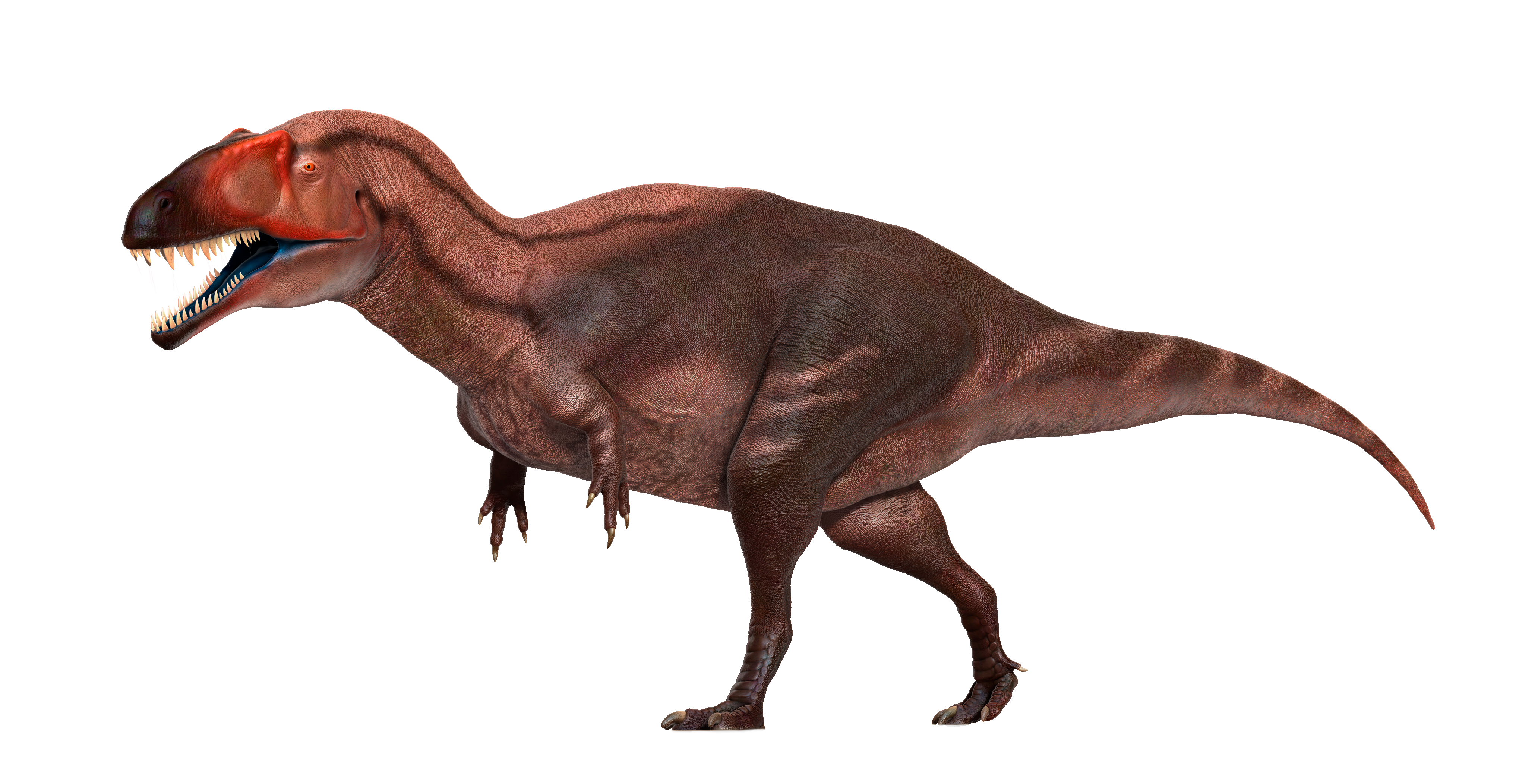|
Meraxes
''Meraxes'' is a genus of carcharodontosaurid theropod dinosaur from the Late Cretaceous Huincul Formation of Argentine Patagonia. The genus contains a single species, ''Meraxes gigas''. Discovery and naming The holotype of ''Meraxes'', previously called the "Campanas carcharodontosaurid", MMCh-PV 65, was discovered in 2012. Known bones include a nearly complete skull, pectoral and pelvic elements, partial forelimbs, complete hindlimbs, fragmentary ribs and cervical and dorsal vertebrae, a sacrum, and several complete caudal vertebrae. It has the most complete carcharodontosaurid skeleton known from the Southern Hemisphere. ''Meraxes gigas'' was described in 2022 by Canale ''et al''. based on these remains. The generic name, "''Meraxes''", honors a dragon from the George R.R. Martin fantasy novel series, '' A Song of Ice and Fire''. The specific name, "''gigas''", is derived from a Greek word meaning "giant", in reference to its large size. Description ''Meraxes'' w ... [...More Info...] [...Related Items...] OR: [Wikipedia] [Google] [Baidu] |
Meraxes Size Comparison
''Meraxes'' is a genus of carcharodontosaurid theropod dinosaur from the Late Cretaceous Huincul Formation of Argentine Patagonia. The genus contains a single species, ''Meraxes gigas''. Discovery and naming The holotype of ''Meraxes'', previously called the "Campanas carcharodontosaurid", MMCh-PV 65, was discovered in 2012. Known bones include a nearly complete skull, pectoral and pelvic elements, partial forelimbs, complete hindlimbs, fragmentary ribs and cervical and dorsal vertebrae, a sacrum, and several complete caudal vertebrae. It has the most complete carcharodontosaurid skeleton known from the Southern Hemisphere. ''Meraxes gigas'' was described in 2022 by Canale ''et al''. based on these remains. The generic name, "''Meraxes''", honors a dragon from the George R.R. Martin fantasy novel series, ''A Song of Ice and Fire''. The specific name, "''gigas''", is derived from a Greek word meaning "giant", in reference to its large size. Description ''Meraxes'' was a ... [...More Info...] [...Related Items...] OR: [Wikipedia] [Google] [Baidu] |
Meraxes Gigas Ilustración Científica Realizada Por Carlos Papolio
''Meraxes'' is a genus of carcharodontosaurid theropod dinosaur from the Late Cretaceous Huincul Formation of Argentine Patagonia. The genus contains a single species, ''Meraxes gigas''. Discovery and naming The holotype of ''Meraxes'', previously called the "Campanas carcharodontosaurid", MMCh-PV 65, was discovered in 2012. Known bones include a nearly complete skull, pectoral and pelvic elements, partial forelimbs, complete hindlimbs, fragmentary ribs and cervical and dorsal vertebrae, a sacrum, and several complete caudal vertebrae. It has the most complete carcharodontosaurid skeleton known from the Southern Hemisphere. ''Meraxes gigas'' was described in 2022 by Canale ''et al''. based on these remains. The generic name, "''Meraxes''", honors a dragon from the George R.R. Martin fantasy novel series, ''A Song of Ice and Fire''. The specific name, "''gigas''", is derived from a Greek word meaning "giant", in reference to its large size. Description ''Meraxes'' was a ... [...More Info...] [...Related Items...] OR: [Wikipedia] [Google] [Baidu] |
Carcharodontosaurid
Carcharodontosauridae (carcharodontosaurids; from the Greek καρχαροδοντόσαυρος, ''carcharodontósauros'': "shark-toothed lizards") is a group of carnivorous theropod dinosaurs. In 1931, Ernst Stromer named Carcharodontosauridae as a family, which, in modern paleontology, indicates a clade within Carnosauria. Carcharodontosaurids include some of the largest land predators ever known: ''Giganotosaurus'', ''Mapusaurus'', ''Carcharodontosaurus'', and ''Tyrannotitan'' all rivaled or exceeded ''Tyrannosaurus'' in size. A 2015 paper by Christophe Hendrickx and colleagues gives a maximum length estimate of for the largest carcharodontosaurids, while the smallest carcharodontosaurids were estimated to have been at least long. Evolution Along with the spinosaurids, carcharodontosaurids were the largest predators in the early and middle Cretaceous throughout Gondwana, with species also present in North America (''Acrocanthosaurus''), Europe (''Concavenator'') and Asia ... [...More Info...] [...Related Items...] OR: [Wikipedia] [Google] [Baidu] |
Carcharodontosauridae
Carcharodontosauridae (carcharodontosaurids; from the Greek καρχαροδοντόσαυρος, ''carcharodontósauros'': "shark-toothed lizards") is a group of carnivorous theropod dinosaurs. In 1931, Ernst Stromer named Carcharodontosauridae as a family, which, in modern paleontology, indicates a clade within Carnosauria. Carcharodontosaurids include some of the largest land predators ever known: ''Giganotosaurus'', ''Mapusaurus'', ''Carcharodontosaurus'', and ''Tyrannotitan'' all rivaled or exceeded ''Tyrannosaurus'' in size. A 2015 paper by Christophe Hendrickx and colleagues gives a maximum length estimate of for the largest carcharodontosaurids, while the smallest carcharodontosaurids were estimated to have been at least long. Evolution Along with the spinosaurids, carcharodontosaurids were the largest predators in the early and middle Cretaceous throughout Gondwana, with species also present in North America (''Acrocanthosaurus''), Europe (''Concavenator'') and Asia ... [...More Info...] [...Related Items...] OR: [Wikipedia] [Google] [Baidu] |
Huincul Formation
The Huincul Formation is a geologic formation of Late Cretaceous ( Early Cenomanian to Late Turonian) age of the Neuquén Basin that outcrops in the Mendoza, Río Negro and Neuquén Provinces of northern Patagonia, Argentina.Huincul Formation at .org It is the second formation in the Río Limay Subgroup, the oldest subgroup within the . Formerly that subgroup was treate ... [...More Info...] [...Related Items...] OR: [Wikipedia] [Google] [Baidu] |
2022 In Archosaur Paleontology
This article records new taxa of fossil archosaurs of every kind that are scheduled described during the year 2022, as well as other significant discoveries and events related to paleontology of archosaurs that are scheduled to occur in the year 2022. Pseudosuchians New pseudosuchian taxa General pseudosuchian research * A study on the mandible embryogenesis in extant caimans, and on its implications for the knowledge of the evolution of postdentary lower jaw of pseudosuchians, is published by Bona ''et al.'' (2022). * A study on the musculature of crocodylian and fossil suchian jaws, investigating the impact of the flattening of the skulls of suchians in their evolutionary history on their muscle anatomy, is published by Sellers ''et al.'' (2022). * Revision of ''Tsylmosuchus donensis'' and ''Scythosuchus basileus'' is published by Sennikov (2022), who interprets the latter taxon as a junior synonym of the former one, and interprets ''T. donensis'' as a likely member of ... [...More Info...] [...Related Items...] OR: [Wikipedia] [Google] [Baidu] |
Late Cretaceous
The Late Cretaceous (100.5–66 Ma) is the younger of two epochs into which the Cretaceous Period is divided in the geologic time scale. Rock strata from this epoch form the Upper Cretaceous Series. The Cretaceous is named after ''creta'', the Latin word for the white limestone known as chalk. The chalk of northern France and the white cliffs of south-eastern England date from the Cretaceous Period. Climate During the Late Cretaceous, the climate was warmer than present, although throughout the period a cooling trend is evident. The tropics became restricted to equatorial regions and northern latitudes experienced markedly more seasonal climatic conditions. Geography Due to plate tectonics, the Americas were gradually moving westward, causing the Atlantic Ocean to expand. The Western Interior Seaway divided North America into eastern and western halves; Appalachia and Laramidia. India maintained a northward course towards Asia. In the Southern Hemisphere, Australia and Ant ... [...More Info...] [...Related Items...] OR: [Wikipedia] [Google] [Baidu] |
George R
George may refer to: People * George (given name) * George (surname) * George (singer), American-Canadian singer George Nozuka, known by the mononym George * George Washington, First President of the United States * George W. Bush, 43rd President of the United States * George H. W. Bush, 41st President of the United States * George V, King of Great Britain, Ireland, the British Dominions and Emperor of India from 1910-1936 * George VI, King of Great Britain, Ireland, the British Dominions and Emperor of India from 1936-1952 * Prince George of Wales * George Papagheorghe also known as Jorge / GEØRGE * George, stage name of Giorgio Moroder * George Harrison, an English musician and singer-songwriter Places South Africa * George, Western Cape ** George Airport United States * George, Iowa * George, Missouri * George, Washington * George County, Mississippi * George Air Force Base, a former U.S. Air Force base located in California Characters * George (Peppa Pig), a 2-year-old pig ... [...More Info...] [...Related Items...] OR: [Wikipedia] [Google] [Baidu] |
A Song Of Ice And Fire
''A Song of Ice and Fire'' is a series of epic fantasy novels by the American novelist and screenwriter George R. R. Martin. He began the first volume of the series, ''A Game of Thrones'', in 1991, and it was published in 1996. Martin, who initially envisioned the series as a trilogy, has published five out of a planned seven volumes. The fifth and most recent volume of the series, ''A Dance with Dragons'', was published in 2011, six years after the publication of the preceding book, ''A Feast for Crows''. He is currently writing the sixth novel, ''The Winds of Winter''. A seventh novel, ''A Dream of Spring'', is planned. ''A Song of Ice and Fire'' takes place on the fictional continents Westeros and Essos. The point of view of each chapter in the story is a limited perspective of a range of characters growing from nine in the first novel, to 31 characters by the fifth novel. Three main stories interweave: a dynastic war among several families for control of Westeros, the risin ... [...More Info...] [...Related Items...] OR: [Wikipedia] [Google] [Baidu] |
Greek Language
Greek ( el, label=Modern Greek, Ελληνικά, Elliniká, ; grc, Ἑλληνική, Hellēnikḗ) is an independent branch of the Indo-European family of languages, native to Greece, Cyprus, southern Italy (Calabria and Salento), southern Albania, and other regions of the Balkans, the Black Sea coast, Asia Minor, and the Eastern Mediterranean. It has the longest documented history of any Indo-European language, spanning at least 3,400 years of written records. Its writing system is the Greek alphabet, which has been used for approximately 2,800 years; previously, Greek was recorded in writing systems such as Linear B and the Cypriot syllabary. The alphabet arose from the Phoenician script and was in turn the basis of the Latin, Cyrillic, Armenian, Coptic, Gothic, and many other writing systems. The Greek language holds a very important place in the history of the Western world. Beginning with the epics of Homer, ancient Greek literature includes many works of lasting impo ... [...More Info...] [...Related Items...] OR: [Wikipedia] [Google] [Baidu] |
Abelisauridae
Abelisauridae (meaning "Abel's lizards") is a family (or clade) of ceratosaurian theropod dinosaurs. Abelisaurids thrived during the Cretaceous period, on the ancient southern supercontinent of Gondwana, and today their fossil remains are found on the modern continents of Africa and South America, as well as on the Indian subcontinent and the island of Madagascar. Isolated teeth were found in the Late Jurassic of Portugal, and the Late Cretaceous genera '' Tarascosaurus'' and ''Arcovenator'' have been described in France. Abelisaurids first appear in the fossil record of the early middle Jurassic period, and at least two genera (the Moroccan ''Chenanisaurus'' and the Madagascan ''Majungasaurus'') survived until the end of the Mesozoic era 66 million years ago. Like most theropods, abelisaurids were carnivorous bipeds. They were characterized by stocky hind limbs and extensive ornamentation of the skull bones, with grooves and pits. In many abelisaurids, such as ''Carnotaurus'', ... [...More Info...] [...Related Items...] OR: [Wikipedia] [Google] [Baidu] |
Acrocanthosaurus
''Acrocanthosaurus'' ( ; ) is a genus of carcharodontosaurid dinosaur that existed in what is now North America during the Aptian and early Albian stages of the Early Cretaceous, from 113 to 110 million years ago. Like most dinosaur genera, ''Acrocanthosaurus'' contains only a single species, ''A. atokensis''. Its fossil remains are found mainly in the U.S. states of Oklahoma, Texas, and Wyoming, although teeth attributed to ''Acrocanthosaurus'' have been found as far east as Maryland, suggesting a continent wide range. ''Acrocanthosaurus'' was a bipedal predator. As the name suggests, it is best known for the high neural spines on many of its vertebrae, which most likely supported a ridge of muscle over the animal's neck, back, and hips. ''Acrocanthosaurus'' was one of the largest theropods, with the largest known specimen reaching in length and weighing approximately . Large theropod footprints discovered in Texas may have been made by ''Acrocanthosaurus'', although there ... [...More Info...] [...Related Items...] OR: [Wikipedia] [Google] [Baidu] |





